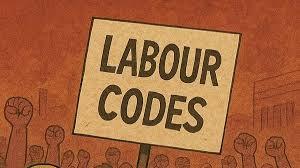1.Introduction: India’s Labour Reform Agenda
India has consolidated 29 labour laws into 4 Labour Codes.
The aim: simplify compliance, ensure worker welfare, and build a future-ready labour ecosystem.
Labour reforms are central to Aatmanirbhar Bharat, economic growth, and social protection.
2. India’s Labour Market: Key Facts
Employment increased:
47.5 crore (2017–18) → 64.33 crore (2023–24)
Net addition: 16.83 crore jobs.
Unemployment rate reduced:
6.0% → 3.2% in same period.
Women entering formal workforce: + 1.56 crore.
Poverty decline parallels labour market improvements.
India’s social protection system is now one of the largest globally.
3. Rationale Behind Codification of Labour Laws
Why merge 29 laws into 4?
(A) Simplify Compliance
Earlier: multiple laws → duplication, confusion.
Now: single registration, single license, single return.
(B) Streamlined Enforcement
Too many authorities earlier → delays, inconsistency.
(C) Modernizing Outdated Laws
Many labour laws were pre-Independence; not suitable for digital economy or platform work.
(D) Reduce Compliance Burden
Supports ease of doing business → boosts investment & employment.
(E) Based on Recommendations
Follows Second National Commission on Labour (2002):
Suggested grouping laws into 4–5 labour codes.
4. Overview of the Four Labour Codes
Code on Wages, 2019
Industrial Relations Code, 2020
Code on Social Security, 2020
Occupational Safety, Health & Working Conditions (OSHWC) Code, 2020
5. Code 1: Code on Wages, 2019
Covers 4 earlier laws
(1) Payment of Wages Act
(2) Minimum Wages Act
(3) Payment of Bonus Act
(4) Equal Remuneration Act
Major Highlights
1. Universal Minimum Wage
Minimum wages apply to all employees (earlier only scheduled employments).
2. Floor Wage
Central Government will set floor wage based on minimum living standard.
States cannot set wages below it.
3. Wage Fixation Criteria
Skill level (unskilled → highly skilled)
Geographical region
Working conditions (hazard, heat, humidity)
4. Gender Equality
No discrimination in hiring or wages based on gender, including transgender persons.
5. Timely Payment for All
Earlier wage protection applied only up to ₹24,000.
Now applies to all workers.
6. Overtime
Overtime = 2 times normal wage.
7. Inspector-cum-Facilitator
Role shifts from policing → guidance + compliance.
8. Compounding & Decriminalisation
First-time offences → monetary fines.
Reduces harassment, promotes compliance.
6. Code 2: Industrial Relations Code, 2020
Combines:
Trade Unions Act (1926)
Standing Orders Act (1946)
Industrial Disputes Act (1947)
Major Highlights
1. Fixed Term Employment (FTE)
Direct, short-term hiring.
Same wages/benefits as permanent workers.
Gratuity after 1 year.
2. Re-skilling Fund
Establishments must deposit 15 days’ wages per retrenched worker for retraining.
3. Recognising Trade Unions
Union with 51% membership → negotiating union.
Or negotiating council.
4. Expanded Definitions
Workers include journalists, sales staff, supervisory employees earning up to ₹18,000.
5. Lay-Off / Closure Threshold Revised
Approval required only for units with 300 workers (earlier 100).
States can raise the limit → flexibility for industry.
6. Provisions for Women
Women must be represented in grievance committees.
7. Strikes/Lockouts: Mandatory Notice
14-day notice required.
Prevents sudden/flash strikes.
8. Digital Processes
E-records, online communication → transparency.
9. Work-from-Home
Recognised for service sector.
7. Code 3: Code on Social Security, 2020
Consolidates 9 laws, including EPF, ESI, Maternity Benefit, Unorganised Workers Act, etc.
Major Highlights
1. Universal ESIC Coverage
No “notified area” restriction.
Mandatory for hazardous work.
2. EPF Reforms
Inquiry limit: 5 years.
Appeals deposit reduced to 25%.
3. Gig & Platform Workers Included
Aggregators must contribute 1–2% of turnover (capped at 5% of payouts).
4. Social Security Fund
For unorganised, gig, and platform workers.
Financed through aggregator contributions and penalties.
5. Uniform Definition of Wages (Very Important for UPSC)
Wages = Basic + DA + Retaining allowance.
At least 50% of remuneration must be counted as wages.
6. Commuting Accidents Included
Travel between home and workplace considered employment injury.
7. Gratuity for FTE
Eligibility after 1 year.
8. Inspector-cum-Facilitator & Digital Compliance
Portal-based inspections; algorithm-driven.
8. Code 4: Occupational Safety, Health & Working Conditions (OSHWC) Code, 2020
Merges 13 laws including Factories Act, Mines Act, BOCW Act, Contract Labour Act, etc.
Major Highlights
1. Single Registration & Licensing
1 registration instead of 6.
For establishments with 10+ workers.
2. Hazardous Work Coverage
Can apply to even 1-worker establishments.
3. Migrant Worker Reforms
Definition expanded to include self-migrating workers.
Benefits:
Annual travel allowance
Portability of PDS
Toll-free helpline
4. Women’s Employment
Women can work in all sectors, including night shifts, with safety measures.
5. Health & Safety
Annual health check-ups.
Safety committees for units with 500+ workers.
6. Contract Labour Reforms
Applicability raised from 20 → 50 workers.
Single national license valid for 5 years.
Welfare facilities compulsory.
7. Working Hours
8 hours/day, 48 hours/week.
Overtime = 2x wages.
8. Appointment Letters Mandatory
Promotes formalisation.
9. National Database for Unorganised Workers (NDUW)
For mapping skills & ensuring portability of benefits.
10. Decriminalisation
Offences punishable by fines can be compounded.
9. Transformative Impact of the Labour Codes
(A) Modernised Labour Governance
Laws aligned with digital economy, gig work, and current industrial patterns.
(B) Strengthened Worker Protection
Universal wage protection
Social security expansion
Workplace safety
Formalisation of jobs
(C) Enhanced Ease of Doing Business
Reduced compliance
Digital records & inspections
Flexibility in hiring & retrenchment
Single licences
(D) Boost to Employment & Investment
Investor confidence rises due to clarity & uniformity.
MSMEs find compliance easier.
(E) Technology-Driven Transparency
Digital inspection
Online registrations
Uniform definition of wages
(F) Harmonised Labour Framework
Replaces multiple overlapping laws with 4 unified Codes.
10. Conclusion (UPSC Mains Ready)
India’s Labour Codes mark a major structural reform, balancing worker welfare with industrial growth.
They simplify compliance, modernize labour laws, ensure wage and social security, and make working conditions safer.
Together, these reforms build a transparent, fair, and future-ready labour ecosystem, supporting India’s journey towards Aatmanirbhar Bharat, higher employment, and sustainable economic growth.






